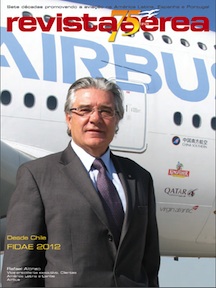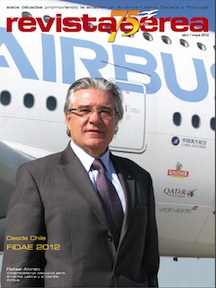UNITED AIRLINES AND AVIANCA BRING NORTH AND SOUTH AMERICA CLOSER TOGETHER THROUGH THEIR CODESHARE AGREEMENT
May 29, 2012
The airlines signed a codeshare agreement, which enables them to sell each other’s tickets, under the same code, starting May 22nd
The agreement allows increased access and seamless travel to the United States for Avianca customers as well as United passengers to Colombia
Customers will be able to enjoy travel on both airlines through a unified process: one ticket purchase, a single check-in, baggage checked all the way through to the final destination, and reciprocal accrual and redemption on either of their frequent flyer programs
During this first phase of implementation the codeshare cities include Denver, Chicago, New York/Newark, Houston, Boston, Cleveland, New Orleans, Phoenix, Raleigh-Durham, San Antonio, Seattle, and Tampa in the United States for Avianca; as well as Bogota, Barranquilla, Cali, Cartagena, Medellin, and Pereira in Colombia, for United
BOGOTA, May XXX, 2012 – United Airlines and Avianca signed a codeshare agreement to offer their clients more and improved flight options. The agreement allows both companies to commercialize flights operated by the other under their own code, therefore combining segments of both airlines under a single ticket. The airlines also signed a frequent flyer agreement which enables reciprocal accrual and redemption benefits on the passengers’ loyalty program of choice.
Avianca’s customers will be able to fly seamlessly to more destinations in the United States, while United customers will benefit from greater access to Colombian destinations. The codeshare agreement is effective for ticket purchase starting on May 22, 2012 for travel starting June 21. The frequent flyer agreement will be effective starting June 21. These agreements form part of the integration process that Avianca and TACA Airlines are undergoing to become member of Star Alliance.
Mirage 2.000 y Mig 29 de la FAP
May 29, 2012
La Fueza Aérea del Perú avanza lentamente en los planes de mantenimiento de sus principales aeronaves de combate, las que han recibido una gran inyección de dinero que alcanza los 266 millones de dólares.
Los trabajos realizados en los Mirage 2000, pese a estar muy atrasados conforme lo recomendado por el fabricante, tienen como objetivo dejarlas habilitadas, dado que por diversas razones han dejado parcialmente de volar, pese a que sus pilotos se encuentran entrenados en aeronaves de la Fuerza Aérea de Francia, país que se ha preocupado de mantenerlos operativos.
Las aeronaves rusas por otra parte (Mig 29), también avanzan en sus mantenimientos no sin dificultades, dado que nada es fácil al parecer en el país incaico y volverán a ser parte activa del inventario del Perú en los próximos años. Las labores de mantención demorarán aproximadamente 2 años, siempre y cuando no existan nuevos contratiempos.
La preocupación del Presidente del Perú, un ex militar, se ha hecho presente en los fondos asignados a las instituciones armadas, las que habían perdido una buena parte de su presupuesto en los años recientes, además de tener reasignaciones de tareas operativas, siendo quizás, el arma aérea la mas afectada por todo lo anterior.
Nuevo centro de instrucción en español
May 25, 2012
Las empresas Eurocopter y Turbomeca, inauguraron en México un Centro de instrucción y capacitación para técnicos en mantenimiento de aeronaves (helicópteros) y motores, cuya principal característica es que realizarán instrucción en idioma español, siendo el primero en América Latina que utiliza este idioma.
Los modelos a instruir, son los Eurocopter AS 350, EC130, 145,225 y 725 además de las aeonaves Dauphin. Demás esta decir, la importancia que reviste lo anterior y los esfuezos que hacen los países europeos por afianzar y respaldar su alta presencia en este lado del atlántico, lo que sin dudas es bienvenido.
New CAE A320 simulator at Airbus Training Centre in Miami is ready for training
May 25, 2012
A new CAE 7000 Series Airbus A320 full-flight simulator (FFS) at the Airbus Training Centre in Miami, Florida USA is ready for training, qualified to FAA Level D Part 60 requirements by the U.S. Federal Aviation Administration (FAA). The CAE-owned FFS also meets the requirements of the latest Airbus Standard 1.7 and features a third-generation CAE TroposTM-6000 visual system. The simulator is part of the Airbus-CAE Training Services Cooperation, a joint global network of training centres with the largest fleet of FFSs for Airbus aircraft types, standardized courseware and expert instructors.
Brazil’s Passaredo Linhas Aéreas introduces ATR 72-600 into its fleet
May 22, 2012
The airline will operate a total fleet of 14 ATR 72-600s and 2 ATR 72-500s
Brazilian carrier Passaredo Linhas Aéreas today introduced the new ATR 72-600 into its fleet. The airline and the US-based leasing company Air Lease Corporation (ALC) have entered into an agreement for the introduction of four ATR 72-600s, and today took delivery of the very first of these aircraft at the ATR facilities in Toulouse, France.
On the occasion of this delivery ceremony, ATR and Passaredo officially unveiled as well that they signed a contract for the purchase of ten ATR 72-600s plus ten options, valued at some US$ 450 million. The airline will introduce the four ATRs leased from ALC and the ten firm aircraft booked with the aircraft manufacturer progressively in 2012, 2013 and 2014, thus bringing to 14 its total fleet of ATR 72-600s. In addition to this fleet of ATR 72-600s, Passaredo will also start operating this year two leased ATR 72-500s.
With the arrival of these new 70-seat ATRs, Passaredo will progressively add passenger capacity and substantially reduce seat-costs on its regional network. The airline will benefit from its Interline Agreement with Brazil’s leading aviation group GOL and will further develop its regional network with the introduction of new routes across the country.
Commenting on the introduction of these aircraft, Steven Udvar-Hazy, Chief Executive Officer of ALC, declared: “We are pleased to add Passaredo to our growing list of customers. Out of a total of twelve ATR 72-600s ordered from ATR since July 2010, we have already placed ten with Brazilian carriers. This is clearly underlining the dynamism of the Brazilian market and that ATRs perfectly match the requirements of the regional operators in Brazil. We are convinced that, due to their strong and increasing attractiveness among regional carriers around the world, the new ATRs will keep providing us with substantial business opportunities in the near future”.
Luiz Felicio, President of Passaredo Linhas Aéreas, declared: “The ATR aircraft is proving itself as the right tool for regional operations in Brazil, as it combines highly reliable performance at small airfields and short runways with the highest standards of passenger comfort and very limited environmental footprint. Both from a cost and modernity perspective, the ATR 72-600 aircraft is definitely the best suited regional aircraft for short-haul operations in Brazil”.
Filippo Bagnato, Chief Executive Officer of ATR, declared: “We are experiencing an extraordinary success in Brazil, where we have booked orders with regional carriers for some 50 ATRs within the last couple of years. This growth of regional operations in Brazil is also creating business opportunities for leasing companies that have invested in the ATR product. Lessors’ interest in ATRs is dramatically increasing. In 2011, the best commercial year for ATR, leasing companies represented more than 20% of the total aircraft sales”.
ATR is well established in Latin America and the Caribbean region, with more than 130 aircraft flying in the livery of 29 operators, including more than 60 aircraft currently being operated in Brazil. Within the next three years, the number of ATRs flying in Brazil will grow beyond 100 aircraft.
At RAA Convention: Demand for new commercial tprop programs grows
May 21, 2012
Prospects brighten for turboprop programs
Minneapolis, MN, May 21, 2012 — In a soon-to-be-released study on the future prospects for turboprop aircraft, findings show a continuing demand for turboprops as well as increasing values for used aircraft. Sponsored by Saab Aircraft Leasing, Aerocentury and Commutair, the study also found that while the current fleet can meet the short-term demands for turboprop aircraft, there is an increased interest for new programs at both ends of the seating spectrum to replace thousands of aging turboprops and regional jets in the worldwide fleet.
The study, authored by long-time regional airline experts Tulinda Larsen and Kathryn Creedy, provides an update for the turboprop aircraft market, investigates mission profiles, fleet demographics, aircraft programs, forecasts demand for turboprop aircraft and provides a discussion on the future opportunities for turboprop aircraft.
“The study confirms what airlines such as Cape Air, SeaPort Airlines, Commutair and Great Lakes Airlines have been saying for years and what new entrant GLO Airways has found,” said study Co-Author Tulinda Larsen, who has been analyzing the industry for decades. “There are markets out there that can be economically served by turboprop aircraft, demonstrating a need for a new generation of turboprops. The significance is, the advent of new, small turboprops could mean the return of air service to many communities. Only Cape Air has gone so far as to actually work with a manufacturer to develop a product but all indications are that it could be successful given the number of turboprops in need of replacement.”
Resurgence in the demand for turboprop aircraft has been spurred because turboprops are the best aircraft for short-distance flights and for challenging operating environments. Factors including volatile fuel prices, additional security fees and increases in overall airline expenses, coupled with declining remuneration in capacity purchase programs, have made operating jets uneconomical on short routes.
“While regional jet values have plummeted, turboprop values have remained robust,” said Co-Author Kathryn Creedy, who has covered the industry since the 1980s. “Companies, such as Saab Aircraft Leasing, have done a masterful job of serving the needs of regional airlines as evidenced by such actions as Silver Airways replacement of its fleet of Beech 1900s with the Saab 340. In addition, airlines are cobbling together expensive mini-manufacturing operations and life-extension programs for turboprops — especially those 36-seats and below — to squeeze life out of the installed fleet of turboprops in all sizes. That bodes well for new aircraft programs that can meet the demand while keeping seat costs reasonable.”
Annual deliveries of turboprop aircraft have been on an uptick since 2005, according to the study analysis. Deliveries in 2011 were more than seven times that of deliveries of the lowest point, 2003. Turboprop deliveries have returned to the 1990s levels with a backlog of more than 400 aircraft.
Today, there are 23,000 turboprop aircraft in active operation around the globe, accounting for half of the world’s aircraft fleet. Of these, 9,000 aircraft (40%) are in scheduled and non-scheduled airline service. The remainder is used in business aviation (8,000 aircraft, 34%) and government (6,000 aircraft, 26%). Turboprop aircraft mission profiles include scheduled air transportation, business aviation and new missions including serving as platforms for exploration and surveillance.
Turboprops are a vital part of the global aircraft fleet. Policymakers, financiers, manufacturers, and operators need a clear understanding of the turboprop market dynamics to develop strategic plans for future products.
Rentabilidad de empresas aéreas
May 21, 2012
En países como en Colombia, donde la el petróleo tiene una gran importancia comercial, la actividad aeronaútica ha pasado a ser aún mas importante que esta última en cuanto a rentabilidad y compiten de igual a igual con empresas tradicionalmente rentables.
Lo anterior, no sólo es válido para dicho país, sino que en varios otros países regionales de nuesta américa, la aviación es un buen negocio, es rentable, presta un buen servicio y da dividendos a sus accionistas, además de tener buenas relaciones laborales con sus empleados, desplazando de esta forma a grandes compañías que explotan tradicionalmente recursos no renovables o materias primas en gran cantidad y de necesidad mundial.
Siendo el petróleo un porcentaje importante en los costos de cualquier aerolínea, estas han sabido absoverlos y traspasarlos a sus clientes de una forma comercialmente buena, sin violencia, lo que ha redundado en estos buenos resultados.
La economía sigue adelante y continúa dándonos ejemplos que no todo es costo y utilidades, sino también, servicios y beneficios, una dupla interesante que debieran entender muchos economistas, dignatarios y en general el mundo empresarial. No todo es ganar dinero, también son importantes los clientes y quienes hacen posible que a la empresa le vaya bien, sus empleados, sin importar la labor que deempeñan dentro de ella, todos son importantes.
Revista Aerea – Abril / Maio 2012
May 16, 2012
Me escribe un sacerdote
May 16, 2012
Mantengo correspondencia electrónica con un sacerdote amigo, el cual no sólo se dedica a los problemas de Dios, sino también a observar la vida cotiadana, el día a día, y le llamaba la atención la cantidad de trámites que se deben realizar para muchas cosas sencillas, como cerrar una cuenta corriente en un banco, cortar un servicio telefónico que no se desea o pedir no recibir mas mensajes en su celular, sólo por mencionar algunos servicios.
La idea pareciera ser, no soltar nunca al cliente y tenerlo cautivo si o si, pero en aviación, pareciese que se avanza en la dirección contraria, no por ello equivocada, al menos respecto al pasajero y los servicios que se prestan a él.
Hoy es posible reservar, comprar, eliminar, cambiar y confirmar un vuelo entre otras cosas mas relacionadas al mismo tema, con sólo un click y un Pc o similares, lo que constituye la parte buena de la modernidad y un ejemplo para muchas compañías de distintos ámbitos, que debiesen aprender de estas.
Un cliente, es una persona a la cual debo cuidar y velar porque el servicio que se le entrega sea lo contratado y esté feliz conmigo, cosa que jamás se atreva a viajar en otra compañía aérea que no sea la nuestra.
Un buen ejemplo de la aviación para el mundo empresarial terrestre y damos gracias a nuestro amigo sacerdote por preocuparse de las cosas sencillas e importantes de la vida terrenal, además de Dios
Revista Aerea – Abril / Mayo 2012
May 14, 2012









